Related Research Articles

Carthage was the capital city of the ancient Carthaginian civilization, on the eastern side of the Lake of Tunis in what is now Tunisia. Carthage was the most important trading hub of the Ancient Mediterranean and one of the most affluent cities of the classical world.
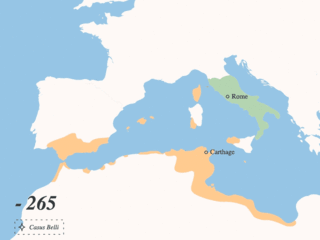
The Punic Wars were a series of wars that were fought between the Roman Republic and Ancient Carthage.

Leptis or Lepcis Magna, also known by other names in antiquity, was a prominent city of the Carthaginian Empire and Roman Libya at the mouth of the Wadi Lebda in the Mediterranean.

The Third Punic War was the third and last of the Punic Wars fought between Carthage and Rome. The war was fought entirely within Carthaginian territory, in modern northern Tunisia. When the Second Punic War ended in 201 BC, one of the terms of the peace treaty prohibited Carthage from waging war without Rome's permission. Rome's ally, King Masinissa of Numidia, exploited this to repeatedly raid and seize Carthaginian territory with impunity. In 149 BC Carthage sent an army, under Hasdrubal, against Masinissa, the treaty notwithstanding. The campaign ended in disaster as the Battle of Oroscopa ended with a Carthaginian defeat and the surrender of the Carthaginian army. Anti-Carthaginian factions in Rome used the illicit military action as a pretext to prepare a punitive expedition.

Drepana was an Elymian, Carthaginian, and Roman port in antiquity on the western coast of Sicily. It was the site of a crushing Roman defeat by the Carthaginians in 249 BC. It eventually developed into the modern Italian city of Trapani.

Colonies in antiquity were post-Iron Age city-states founded from a mother-city, not from a territory-at-large. Bonds between a colony and its metropolis remained often close, and took specific forms during the period of classical antiquity. Generally, colonies founded by the ancient Phoenicians, Carthage, Rome, Alexander the Great and his successors remained tied to their metropolis, but Greek colonies of the Archaic and Classical eras were sovereign and self-governing from their inception. While Greek colonies were often founded to solve social unrest in the mother-city, by expelling a part of the population, Hellenistic, Roman, Carthaginian, and Han Chinese colonies were used for expansion and empire-building.
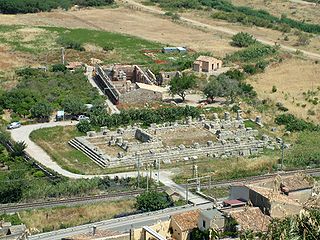
Himera, was a large and important ancient Greek city, situated on the north coast of Sicily at the mouth of the river of the same name, between Panormus and Cephaloedium in the comune of Termini Imerese.

Utica was an ancient Phoenician and Carthaginian city located near the outflow of the Medjerda River into the Mediterranean, between Carthage in the south and Hippo Diarrhytus in the north. It is traditionally considered to be the first colony to have been founded by the Phoenicians in North Africa. After Carthage's loss to Rome in the Punic Wars, Utica was an important Roman colony for seven centuries.

Hadrumetum, also known by many variant spellings and names, was a Phoenician colony that pre-dated Carthage. It subsequently became one of the most important cities in Roman Africa before Vandal, Byzantine, and Umayyad conquerors left it ruined. In the early modern period, it was the village of Hammeim, now part of Sousse, Tunisia.

Cirta, also known by various other names in antiquity, was the ancient Berber and Roman settlement which later became Constantine, Algeria. Cirta was the capital city of the Berber kingdom of Numidia; its strategically important port city was Russicada. Although Numidia was a key ally of the ancient Roman Republic during the Punic Wars, Cirta was subject to Roman invasions during the 2nd and 1st centuries BC. Eventually it fell under Roman dominion during the time of Julius Caesar. Cirta was then repopulated with Roman colonists by Caesar and Augustus and was surrounded by the autonomous territory of a "Confederation of four free Roman cities", ruled initially by Publius Sittius. The city was destroyed in the beginning of the 4th century and was rebuilt by the Roman emperor Constantine the Great, who gave his name to the newly constructed city, Constantine. The Vandals damaged Cirta, but emperor Justinian I reconquered and improved the Roman city. It declined in importance after the Muslim invasions, but a small community continued at the site for several centuries. Its ruins are now an archaeological site.

Motya was an ancient and powerful city on San Pantaleo Island off the west coast of Sicily, in the Stagnone Lagoon between Drepanum and Lilybaeum. It is within the present-day commune of Marsala, Italy.

Maktar or Makthar, also known by other names during antiquity, is a town and archaeological site in Siliana Governorate, Tunisia.

After the destruction of Punic Carthage in 146 BC, a new city of Carthage was built on the same land in the mid-1st century BC. By the 3rd century, Carthage had developed into one of the largest cities of the Roman Empire, with a population of several hundred thousand. It was the center of the Roman province of Africa, which was a major breadbasket of the empire. Carthage briefly became the capital of a usurper, Domitius Alexander, in 308–311. Conquered by the Vandals in 439, Carthage served as the capital of the Vandal Kingdom for a century. Re-conquered by the Eastern Roman Empire in 533-534, it continued to serve as an Eastern Roman regional center, as the seat of the praetorian prefecture of Africa. The city was sacked and destroyed by Umayyad Arab forces after the Battle of Carthage in 698 to prevent it from being reconquered by the Byzantine Empire. A fortress was built on the site and garrisoned by Muslim forces until the Hafsid period, when it was captured by Crusaders during the Eighth Crusade. After the withdrawal of the Crusaders, the Hafsids decided to destroy the fortress to prevent any future use by a hostile power. Roman Carthage was then used as a source of building materials for Kairouan and Tunis in the 8th century.
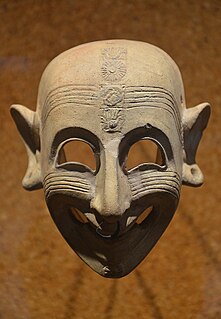
The Punics, Carthaginians or Western Phoenicians, were a group of peoples in the Western Mediterranean who traced their origins to the Phoenicians. In modern scholarship, the term 'Punic' – the Latin equivalent of the Greek-derived term 'Phoenician' – is exclusively used to refer to Phoenicians in the Western Mediterranean, following the line of the Greek East and Latin West.
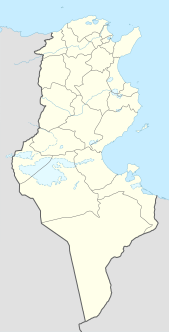
Leptis or Lepcis Parva was a Phoenician colony and Carthaginian and Roman port on Africa's Mediterranean coast, just south of the modern city of Monastir, Tunisia. In antiquity, it was one of the wealthiest cities in the region.

The city of Carthage was founded in the 9th century BC on the coast of Northwest Africa, in what is now Tunisia, as one of a number of Phoenician settlements in the western Mediterranean created to facilitate trade from the city of Tyre on the coast of what is now Lebanon. The name of both the city and the wider republic that grew out of it, Carthage developed into a significant trading empire throughout the Mediterranean. The date from which Carthage can be counted as an independent power cannot exactly be determined, and probably nothing distinguished Carthage from the other Phoenician colonies in Northwest Africa and the Mediterranean during 800–700 BC. By the end of the 7th century BC, Carthage was becoming one of the leading commercial centres of the West Mediterranean region. After a long conflict with the emerging Roman Republic, known as the Punic Wars, Rome finally destroyed Carthage in 146 BC. A Roman Carthage was established on the ruins of the first. Roman Carthage was eventually destroyed—its walls torn down, its water supply cut off, and its harbours made unusable—following its conquest by Arab invaders at the close of the 7th century. It was replaced by Tunis as the major regional centre, which has spread to include the ancient site of Carthage in a modern suburb.

Icosium was a Berber city that was part of Numidia which became an important Roman colony: in Icosium were settled many Roman colonists since Augustus times and there was an early medieval bishopric in what is now the casbah area of actual Algiers.
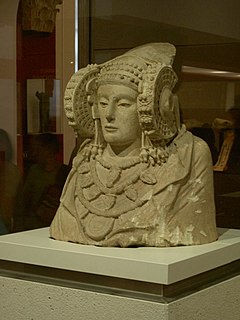
The Carthaginian presence in Iberia lasted from 575 BC to 206 BC when the Carthaginians were defeated by the Roman Republic at the Battle of Ilipa in the Second Punic War.

Carthage was an ancient Phoenician city-state and civilization located in Tunisia. At its height in the fourth century BC, the Carthaginian Empire was among the major powers of the ancient world, dominating the commercial, maritime, and political affairs of the western Mediterranean until the mid third century BC.
Massalia was an ancient Greek colony founded ca. 600 BC on the Mediterranean coast of present-day France, east of the river Rhône, by Ionian settlers from Phocaea, in Western Anatolia. After the capture of Phocaea by the Persians in 545 BC, a new wave of settlers fled towards the colony. Marseille is the oldest city of France, and one of Europe's oldest continuously inhabited settlements.
References
- ↑ Hooper, Finley (1979). Roman Realities . Wayne State University Press. p. 173. ISBN 0-8143-1594-1.
- 1 2 E. T. Salmon, Roman Colonization Under the Republic (Aspects of Greek and Roman life). London: Thames and Hudson, 1969, p. 119
- ↑ "Carthage (ancient city)". encarta.msn.org. Archived from the original on October 28, 2009. Retrieved 2 November 2016.